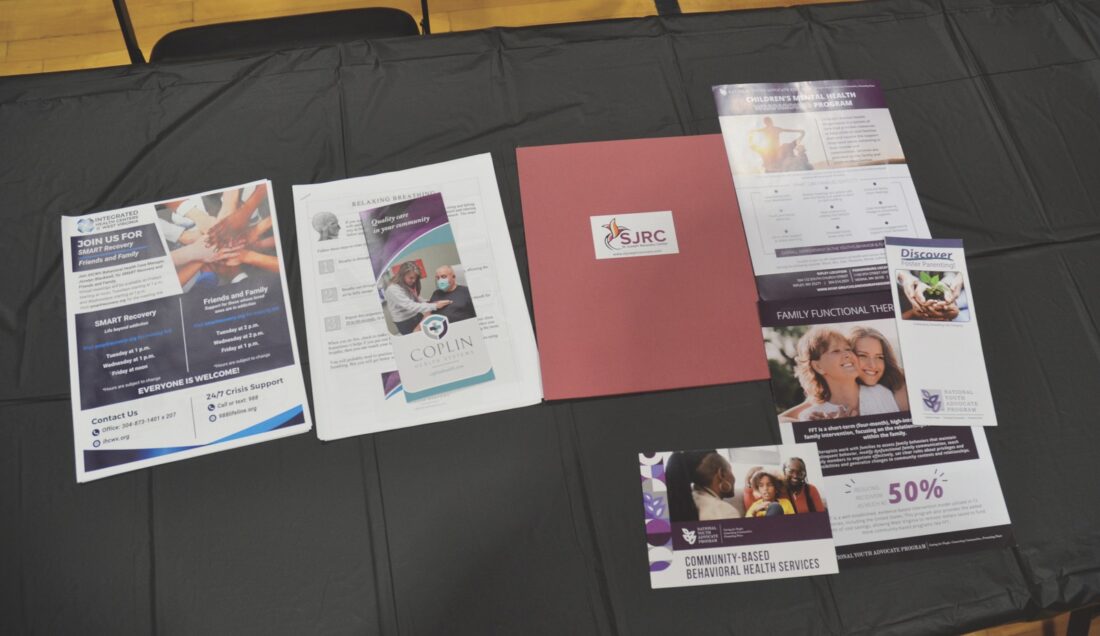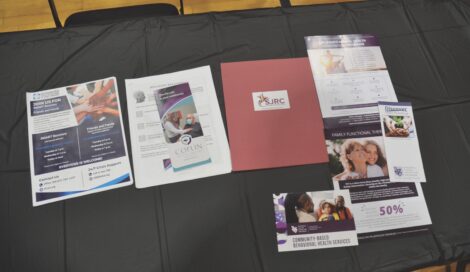Social Media Mindsets: Mental health care specialists weigh-in on student device usage
- Sarah Casseday, right, director of behavioral health at Coplin Health Systems, shares information with other mental health care specialists Monday at Edison Middle School. (Photo by Douglass Huxley)
- Mental health specialists from around the area gathered Monday at Edison Middle School to share their thoughts on how students use their cell phones and their activities on social media. (Photo by Douglass Huxley)

Sarah Casseday, right, director of behavioral health at Coplin Health Systems, shares information with other mental health care specialists Monday at Edison Middle School. (Photo by Douglass Huxley)
PARKERSBURG — Area mental health specialists say it’s best for parents to set rules and expectations about cell phone and social media use when their children begin using them.
“It needs to start as soon as you introduce it…rules need to be from day one,” said Lisa Fleak, Licensed Professional Counselor at Integrated Health Centers of West Virginia.
Local mental health and education professionals gathered at Edison Middle School on Monday night to address the challenging intersections of youth, technology, social media and parenting in today’s digital world.
The roundtable featured insights from counselors, therapists and school psychologists from Wood County Schools, St Joseph Recovery Centers, Coplin Health Systems, Integrated Health Centers of West Virginia and the National Youth Advocate Program.
The group said practical advice for families include: set device boundaries early and clearly; use built-in parental controls; model responsible usage; maintain transparency through regular device checks; and reach out to schools or community health workers for support.

Mental health specialists from around the area gathered Monday at Edison Middle School to share their thoughts on how students use their cell phones and their activities on social media. (Photo by Douglass Huxley)
“For parents and caregivers… schools and community health workers can provide resources and assistance for setting up controls or identifying risks on a child’s phone,” Holly Yoke, Wood County Schools school psychologist, said.
The group said the biggest thing parents can do is be active with their children’s phone use, monitor the way they use devices and regulate the time they are using them.
“My biggest frustration with my families is they don’t feel they have a right to monitor how much time their kids spend on their devices,” Debbie Loy, Safe at Home facilitator for the National Youth Advocate Program, said. “It’s just hard for parents to understand that they do have the right.”
The group said most cell phones have built-in parental controls to set time limits for social media, texting, receiving calls and app usage. Yoke said parents often underestimate the controls available without needing additional paid apps.
“You can set parent controls on pretty much any cell phone…parents think they have to purchase, like a Life360 and you don’t…most phones have those parental controls available to them,” Yoke said. “You can set time limits for social media. You can set time limits for texting and receiving calls, you can even make it so, like, emergency contacts for the kids are the only calls that get through at certain times.”
Sarah Casseday, director of behavioral health at Coplin Health System, said she supports open conversations and transparency about online activity as part of boundary-setting. She said she set these boundaries with her own daughter.
“If you’re going to have socials, I’m going to be friends with you, or I’m going to be on them…so then when she would post new things, I could heart (react) it, and she knew, ‘Okay, mom’s seeing this,'” Casseday said.
She said she also made her daughter share all of her passwords with her.
“That was day one, she had to give us her passwords when she got that phone,” Casseday said. “If she didn’t, then you’re not mature enough to have the phone. If you’re doing things you need to hide from me.”
The group also said it was important to monitor device use at bedtime for kids.
“Make sure phones aren’t in rooms at night,” Yoke said. “Because we know kids aren’t sleeping, especially our adolescents, they’re on social media and just monitoring that.”
The group said practical advice for families includes: set device boundaries early and clearly; use built-in parental controls; model responsible usage; maintain transparency through regular device checks; and reach out to schools or community health workers for support.
“For parents and caregivers… schools and community health workers can provide resources and assistance for setting up controls or identifying risks on a child’s phone,” Yoke said.
The group generally agreed that setting aside a shared device-free time for the whole family, especially around meals, helps model healthy habits and encourages face-to-face communication. The emphasis was on consistency–phones should be set aside not just for kids, but for parents as well, making it a true family activity.
“I’ve talked to families about even an electronic free hour around the dinner hour, and they go in a basket, and that’s parents and kids,” Yorke said.
Yorke reiterated the best thing parents can do is be active with their child’s online usage.
“It comes back to knowing what they have access to, and as much as you can control that, and I think starting that from the beginning, and kids having that knowledge that sometimes that’s a privilege… mom and dad can check that at any point and then take it away,” Yorke said.
A list of guidelines parents can use to help with children’s online and device usage:
1. Parental Rights and Boundaries:
Parents have the right–and responsibility–to monitor and set limits on their child’s phone use, including when and how the phone can be used.
Suggested removing phones from children’s bedrooms at night to prevent late-night use and sleep disruption.
2. Parental Controls and Monitoring:
Most cell phones have built-in parental controls to set time limits for social media, texting, receiving calls, and app usage.
Parents often underestimate the controls available without needing additional paid apps.
Regular device checks were encouraged (including having access to passwords for apps and social accounts).
3. Modeling Appropriate Use:
Adults should model healthy phone habits (e.g., putting phones away during meals or important times, not using devices as constant distractions).
Family-wide “electronic-free hour” (such as around dinner time) was suggested to encourage face-to-face interaction.
4. Rules and Contracts:
Establish clear, upfront rules with children about expectations and consequences regarding phone/device use.
Consider using a written “technology contract” outlining rules, such as sharing passwords, acceptable online behaviors, privacy, and what happens if expectations aren’t met.
5. Adapt to Kid’s Realities and Risks:
Acknowledge that total restriction is neither practical nor always effective; guide kids to safe and responsible use.
Talk to kids about risks: cyberbullying, oversharing personal info, dangerous online interactions, and social media’s impact on self-image and privacy.
Educate children early about how algorithms and online platforms can influence behavior and mood.
6. Seek Support:
For parents and caregivers (especially those less tech-savvy, like grandparents), schools and community health workers can provide resources and assistance for setting up controls or identifying risks on a child’s phone.








